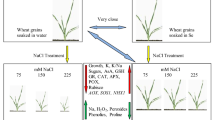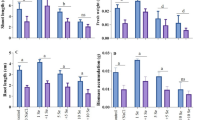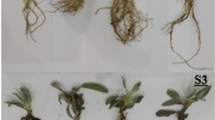Abstract
Hydroponic experiments were conducted to investigate the effects of different concentrations of sodium selenate (Na2SeO4) and sodium selenite (Na2SeO3) on durum wheat seed germination and seedling growth under salt stress. The treatments used were 0 and 50 mM NaCl solutions, each supplemented with Na2SeO4 or Na2SeO3 at 0, 0.1, 1, 2, 4, 8, or 10 μM. Salt alone significantly inhibited seed germination and reduced seedling growth. Addition of low concentrations (0.1–4 μM) of Na2SeO4 or Na2SeO3 mitigated the adverse effects of salt stress on seed germination, biomass accumulation, and other physiological attributes. Among them, 1 μM Na2SeO4 was most effective at restoring seed germination rate, germination energy, and germination index, significantly increasing these parameters by about 12.35, 24.17, and 11.42%, respectively, compared to salt-stress conditions. Adding low concentrations of Na2SeO4 or Na2SeO3 to the salt solution also had positive effects on chlorophyll fluorescence indices, decreased the concentrations of free proline and malondialdehyde, as well as electrolyte leakage, and increased catalase, superoxide dismutase, and peroxidase activities in roots and shoots. However, high concentrations (8–10 μM) of Na2SeO4 or Na2SeO3 disrupted seed germination and seedling growth, with damage caused by Na2SeO3 being more severe than that by Na2SeO4. It is thus clear that exogenous selenium can improve the adaptability of processing wheat to salt stress and maintain higher photosynthetic rate by decreasing the accumulation of reactive oxygen species and alleviating the degree of membrane lipid peroxidation. Na2SeO4 was more effective than Na2SeO3 at all given concentrations.





Similar content being viewed by others
Abbreviations
- CAT:
-
Catalase
- EC:
-
Electrical conductivity
- GE:
-
Germination energy
- GI:
-
Germination index
- GR:
-
Germination rate
- Fm:
-
Maximal fluorescence yield
- Fo:
-
Minimal fluorescence yield
- Fv:
-
Variable fluorescence
- Fv/Fo:
-
Potential efficiency of PSII
- Fv/Fm:
-
Maximal PSII photochemical efficiency
- FW:
-
Fresh weight
- MDA:
-
Malondialdehyde
- Na2SeO3 :
-
Sodium selenite
- Na2SeO4 :
-
Sodium selenate
- NPQ:
-
Non-photochemical quenching
- POD:
-
Peroxidase
- PSII:
-
Photosystem
- RILs:
-
Recombinant inbred lines
- ROS:
-
Reactive oxygen species
- RuBisCO:
-
Ribulose-1, 5-bisphosphate carboxylase/oxygenase
- Se:
-
Selenium
- SeO32− :
-
Selenite
- SeO42− :
-
Selenate
- SOD:
-
Superoxide dismutase
- Y(II):
-
Photochemical quantum yield
References
Abei H (1984) Catalase in vitro. Methods Enzymol 105:121–126. https://doi.org/10.1016/s0076-6879(84)05016-3
Ahanger MA, Aziz U, Alsahli AA, Alyemeni MN, Ahmad P (2020) Influence of exogenous salicylic acid and nitric oxide on growth, photosynthesis, and ascorbate-glutathione cycle in salt stressed vigna angularis. Biomolecules 10(1):42–58. https://doi.org/10.3390/biom10010042
Ahmad P, Jaleel CA, Salem MA, Nabi G, Sharma S (2010) Roles of enzymatic and nonenzymatic antioxidants in plants during abiotic stress. Crit Rev Biotechnol 30(3):161–175. https://doi.org/10.3109/07388550903524243
Ahmad P, Allah EF, Hashem A, Sarwat M, Gucel S (2016) Exogenous application of selenium mitigates cadmium toxicity in Brassica juncea L. (Czern & Cross) by up-regulating antioxidative system and secondary metabolites. J Plant Growth Regul 35(4):936–950. https://doi.org/10.1007/s00344-016-9592-3
Alyemeni MN, Ahanger MA, Wijaya L, Alam P, Bhardwaj R, Ahmad P (2018) Selenium mitigates cadmium-induced oxidative stress in tomato (Solanum lycopersicum L.) plants by modulating chlorophyll fluorescence, osmolyte accumulation, and antioxidant system. Protoplasma 255(3):459–469. https://doi.org/10.1007/s00709-017-1162-4
Balistrieri LS, Chao TT (1990) Adsorption of selenium by amorphous iron oxyhydroxide and manganese dioxide. Geochim Cosmochim Acta 54(3):739–751. https://doi.org/10.1016/0016-7037(90)90369-v
Bates LS, Waldren RP, Teare ID (1973) Rapid determination of free proline for water-stress studies. Plant Soil 39(1):205–207. https://doi.org/10.1007/BF00018060
Beauchamp C, Fridovich I (1971) Superoxide dismutase: improved assays and an assay applicable to acrylamide gels. Anal Bioanal Chem 44:276–287. https://doi.org/10.1016/0003-2697(71)90370-8
Biswojit D, Mubasher H, Muhammad I, Sangeeta M, Min L, Shuang L, Qiu D (2018) Exogenous melatonin mitigates acid rain stress to tomato plants through modulation of leaf ultrastructure, photosynthesis and antioxidant potential. Molecules 23:388–398. https://doi.org/10.3390/molecules23020388
Bukhat S, Manzoor H, H-u-R Athar, Zafar ZU, Rasul S (2019) Salicylic acid induced photosynthetic adaptability of raphanus sativus to salt Stress is associated with antioxidant capacity. J Plant Growth Regul 2019:1–14. https://doi.org/10.1007/s00344-019-10024-z
Cengiz K, David H, Muhammad A, Mohammed N, Parvaiz A (2019) Integrative roles of nitric oxide and hydrogen sulfide in melatonin-induced tolerance of pepper (Capsicum annuum L.) plants to iron deficiency and salt stress alone or in combination. Physiol Plant 168(2):256–277. https://doi.org/10.1111/ppl.12976
D’Amato R (2018) The selenium supplementation influences olive tree production and oil stability against oxidation and can alleviate the water deficiency effects. Front Plant Sci 9:1191–1199. https://doi.org/10.3389/fpls.2018.01191
Elkelish AA, Soliman MH, Alhaithloul HA, El-Esawi MA (2019) Selenium protects wheat seedlings against salt stress-mediated oxidative damage by up-regulating antioxidants and osmolytes metabolism. Plant Physiol Biochem 137:1–8. https://doi.org/10.1016/j.plaphy.2019.02.004
Feng W (2018) The FERONIA receptor kinase maintains cell-wall integrity during salt stress through Ca2+ signaling. Curr Biol 28(5):666–675. https://doi.org/10.1016/j.cub.2018.01.023
Foti C, Khah EM, Pavli OI (2018) Germination profiling of lentil genotypes subjected to salinity stress. Plant Biol 21(3):480–486. https://doi.org/10.1111/plb.12714
Gong X, Yu H, Chen J, Han B (2012) Cell surface properties of Lactobacillus salivarius under osmotic stress. Eur Food Res Technol 234(4):671–678. https://doi.org/10.1007/s00217-012-1677-z
Handa N, Kohli SK, Sharma A, Thukral AK, Ahmad P (2018a) Selenium modulates dynamics of antioxidative defence expression, photosynthetic attributes and secondary metabolites to mitigate chromium toxicity in Brassica juncea L. Plants Environ Exp Bot 161:180–192. https://doi.org/10.1016/j.envexpbot.2018.11.009
Handa N, Kohli SK, Thukral AK, Bhardwaj R, Ahmad P (2018b) Protective role of selenium against chromium stress involving metabolites and essential elements in Brassica juncea L. seedlings. Biotech 8(1):66–75. https://doi.org/10.1007/s13205-018-1087-4
Handa N, Sukhmeen KK, Anket S, Ashwani KT, Renu B, Mohammed N, Leonard W, Parvaiz A (2018c) Selenium ameliorates chromium toxicity through modifications in pigment system, antioxidative capacity, osmotic system, and metal chelators in Brassica juncea seedlings. South Afr J Bot 119:1–10. https://doi.org/10.1016/j.sajb.2018.08.003
Harpreet K, Geetika S, Renu B, Alyemeni MN, Siddique KHM, Parvaiz A (2018) 28-homobrassinolide regulates antioxidant enzyme activities and gene expression in response to salt- and temperature-induced oxidative stress in Brassica juncea. Sci Rep 8:8735–8746. https://doi.org/10.1038/s41598-018-27032-w
Hawrylak-Nowak B (2009) Beneficial effects of exogenous selenium in cucumber seedlings subjected to salt stress. Biol Trace Elem Res 132(1–3):259–269. https://doi.org/10.1007/s12011-009-8402-1
Hawrylak-Nowak B, Dresler S, Rubinowska K, Matraszek-Gawron R, Woch W, Hasanuzzaman M (2018) Selenium biofortification enhances the growth and alters the physiological response of lamb’s lettuce grown under high temperature stress. Plant Physiol Biochem S0981–9428(18):30176. https://doi.org/10.1016/j.plaphy.2018.04.018
Heath RL, Packer L (1968) Photoperoxidation in isolated chloroplasts: I. Kinetics and stoichiometry of fatty acid peroxidation. Arch Biochem Biophys 125:189–198. https://doi.org/10.1016/0003-9861(68)90654-1
Huang B et al (2018) Oxidative damage and antioxidative indicators in 48h germinated rice embryos during the vitrification–cryopreservation procedure. Plant Cell Rep 37(9):1325–1342. https://doi.org/10.1007/s00299-018-2315-4
Huihui Z et al (2020) Toxic effects of heavy metals Pb and Cd on mulberry (Morus alba L.) seedling leaves: Photosynthetic function and reactive oxygen species (ROS) metabolism responses. Ecotox Environ Saf 195:110–119. https://doi.org/10.1016/j.ecoenv.2020.110469
Jawad Hassan M et al (2020) Selenium and salt interactions in black gram (Vigna mungo L): ion uptake, antioxidant defense system, and photochemistry efficiency. Plants 9:467–476. https://doi.org/10.3390/plants9040467
Jiang C, Zu C, Lu D, Zheng Q, Shen J, Wang H, Li D (2017) Effect of exogenous selenium supply on photosynthesis, Na+ accumulation and antioxidative capacity of maize (Zea mays L.) under salinity stress. Sci Rep 7:420–429. https://doi.org/10.1038/srep42039
José PM, Acuña KI, Angela SA, Camila S, Alfredo S, Corcuera LJ, Bravo LA (2015) Photosynthetic light responses may explain vertical distribution of hymenophyllaceae species in a temperate rainforest of southern chile. PLoS ONE 10(12):e0145475. https://doi.org/10.1371/journal.pone.0145475
Khorobrykh S, Havurinne V, Mattila H, Tyystjärvi E (2020) Oxygen and ROS in photosynthesis. Plants 9(1):91–100. https://doi.org/10.3390/plants9010091
Kong L, Wang M, Bi D (2005) Selenium modulates the activities of antioxidant enzymes, osmotic homeostasis and promotes the growth of sorrel seedlings under salt stress. Plant Growth Regul 45:155–163. https://doi.org/10.1007/s10725-005-1893-7
Liu H, Xia Y, Fan H, Xu Q, Du S, Fang Z, Xia H (2018) Effect of imidazolium-based ionic liquids with varying carbon chain lengths on arabidopsis thaliana: response of growth and photosynthetic fluorescence parameters. J Hazard Mater 358(SEP.15):327–336. https://doi.org/10.1016/j.jhazmat.2018.06.046
Li J, Cang Z, Feng J, Bai X, Ding Z, Zhai R (2017) Influence of drought stress on photosynthetic characteristics and protective enzymes of potato at seedling stage. J Saudi Soc Agric Sci 16(1):82–88. https://doi.org/10.1016/j.jssas.2015.03.001
Liu C, Dai Z, Sun H (2017) Potential of duckweed (Lemna minor) for removal of nitrogen and phosphorus from water under salt stress. J Environ Manag 187(1):497–503. https://doi.org/10.1016/j.jenvman.2016.11.006
Meetu G, Shikha G (2016) An overview of selenium uptake, metabolism, and toxicity in plants. Front Plant Sci. https://doi.org/10.3389/fpls.2016.02074
Miner GL, Bauerle WL, Baldocchi DD (2017) Estimating the sensitivity of stomatal conductance to photosynthesis: a review. Plant Cell Environ 40(7):1214–1238. https://doi.org/10.1111/pce.12871
Moulick D, Ghosh D, Chandra SS (2016) Evaluation of effectiveness of seed priming with selenium in rice during germination under arsenic stress. Plant Physiol Biochem 109(12):571–578. https://doi.org/10.1016/j.plaphy.2016.11.004
Nassar RMA, Kamel HA, Ghoniem AE, Alarcón JJ, Sekara A, Ulrichs C, Abdelhamid MT (2020) Physiological and anatomical mechanisms in wheat to cope with salt Stress induced by seawater. Plants 9:237–246. https://doi.org/10.3390/plants9020237
Ni Z, Lu Q, Huo H, Zhang H (2019) Estimation of chlorophyll fluorescence at different scales: a review. Sensors 19(13):3000–3009. https://doi.org/10.3390/s19133000
Peleg Z (2008) High-density genetic map of durum wheat×wild emmer wheat based on SSR and DArT markers. Theor Appl Climatol 117(4):103–115. https://doi.org/10.1007/s00122-008-0756-9
Peleg Z, Fahima T, Krugman T, Abbo S, Yakir D, Korol AB, Saranga Y (2010) Genomic dissection of drought resistance in durum wheat x wild emmer wheat recombinant inbreed line population. Plant Cell Environ 32(7):758–779. https://doi.org/10.1111/j.1365-3040.2009.01956.x
Pilon C et al (2018) Assessing stomatal and non-stomatal limitations to carbon assimilation under progressive drought in peanut (Arachis hypogaea L.). J Plant Physiol 231:124–134. https://doi.org/10.1016/j.jplph.2018.09.007
Pleban J, Guadagno CR, Mackay D, Weinig C, Ewers B (2020) Rapid chlorophyll a fluorescence light response curves mechanistically inform photosynthesis modeling. Plant Physiol:pp.00375.02019. https://doi.org/10.1104/pp.19.00375
Qin X, Nie Z, Liu H, Zhao P, Qin S, Shi Z (2018) Influence of selenium on root morphology and photosynthetic characteristics of winter wheat under cadmium stress. Environ Exp Bot 150:232–239. https://doi.org/10.1016/j.envexpbot.2018.03.024
Sarabi B (2019) Stomatal and non-stomatal limitations are responsible in down-regulation of photosynthesis in melon plants grown under the saline condition: Application of carbon isotope discrimination as a reliable proxy. Plant Physiol Biochem 141:1–19. https://doi.org/10.1016/j.plaphy.2019.05.010
Sui N, Wang Y, Liu S, Yang Z, Wang F, Wan S (2018) Transcriptomic and physiological evidence for the relationship between unsaturated fatty acid and salt stress in peanut. Front Plant Sci 9:7–15. https://doi.org/10.3389/fpls.2018.00007
Upadhyaya A, Sankhla D, Davis TD, Sankhla N, Smith BN (1985) Effect of paclobutrazol on the activities of some enzymes of activated oxygen metabolism and lipid peroxidation in senescing soybean leaves. J Plant Physiol. 121(5):453–461. https://doi.org/10.1016/S0176-1617(85)80081-X
Wang Y, Le L, Cui W, Sheng X, Shen W, Ren W (2012) Hydrogen sulfide enhances alfalfa (Medicago sativa) tolerance against salinity during seed germination by nitric oxide pathway. Plant Soil 351(2):107–119. https://doi.org/10.1007/s11104-011-0936-2
Wang L, Pan D, Li J, Tan F, Hoffmannbenning S, Liang W, Chen W (2015) Proteomic analysis of changes in the Kandelia candel chloroplast proteins reveals pathways associated with salt tolerance. Plant Sci 231:159–172. https://doi.org/10.1016/j.plantsci.2014.11.013
Wei J, Hu C, Ming J, Zhao Y, Xin J, Sun X, Zhao X (2018) Action of selenium against Sclerotinia sclerotiorum: Damaging membrane system and interfering with metabolism. Pestic Biochem Phys 150(2):10–16. https://doi.org/10.1016/j.pestbp.2018.06.003
Wu YW (2019) Effect of low-nitrogen stress on photosynthesis and chlorophyll fluorescence characteristics of maize cultivars with different low-nitrogen tolerances. J Integr Agric 18:1246–1256. https://doi.org/10.1016/S2095-3119(18)62030-1
Wu H, Zhang X, Giraldo JP, Shabala S (2018) It is not all about sodium: revealing tissue specificity and signalling roles of potassium in plant responses to salt stress. Plant Soil 431(1–3):1–17. https://doi.org/10.1007/s11104-018-3770-y
Xiao ZY, Guo JD (2007) Metabolic responses of weeping willows to selenate and selenite. Environ Sci Pollut Res 14(7):510–517. https://doi.org/10.1065/espr2007.04.407
Ya WW (2019) Effect of low-nitrogen stress on photosynthesis and chlorophyll fluorescence characteristics of maize cultivars with different low-nitrogen tolerances. J Integr Agric 18(9):1246–1256. https://doi.org/10.1016/s2095-3119(18)62030-1
Yan J, Xue W, Yang RZ, Qin HB, Zhao G, Fahima T, Cheng JP (2018) Quantitative trait loci conferring grain selenium nutrient in durum wheat × wild emmer wheat RIL population. Czech J Genet Plant Breed 54(2):1–9. https://doi.org/10.17221/112/2016-cjgpb
Zhang H (2018) Rootstock alleviates salt stress in grafted mulberry seedlings: physiological and PSII function responses. Front Plant Sci 9(12):1–12. https://doi.org/10.3389/fpls.2018.01806
Zvi P, Ismail C, Levent O, Atilla Y, Yan J, Hikmet B, Abraham B, Tzion F, Yehoshua S (2009) Quantitative trait loci conferring grain mineral nutrient concentrations in durum wheat x wild emmer wheat RIL population. Theor Appl Climatol 119(3):353–369. https://doi.org/10.1007/s00122-009-1044-z
Acknowledgements
This work was supported by the National Science Foundation of China (31560578), the cultivation Project of Sichuan Science and Technology Innovation Seedling Program (2019101), Sichuan International Science and Technology Cooperation and Exchange Research and Development Project (2018HH0116), and China–Israel cooperation program grants from the Ministry of Science and Technology in China (2013DFA32200).
Author information
Authors and Affiliations
Contributions
Yong Liang and Jun Yan contributed to the study conception and design. Reagents, materials, and analysis tools were contributed by Jianping Cheng, Gang Zhao, Tzion Fahima, and Jun Yan. The draft of the manuscript was written by Yong Liang, Daqing Li, and Yuexing Chen. All authors read and approved the final manuscript.
Corresponding author
Ethics declarations
Conflict of interest
All the authors declare no conflict of interest with respect to this paper.
Electronic supplementary material
Below is the link to the electronic supplementary material.
Rights and permissions
About this article
Cite this article
Liang, Y., Li, D., Chen, Y. et al. Selenium mitigates salt-induced oxidative stress in durum wheat (Triticum durum Desf.) seedlings by modulating chlorophyll fluorescence, osmolyte accumulation, and antioxidant system. 3 Biotech 10, 368 (2020). https://doi.org/10.1007/s13205-020-02358-3
Received:
Accepted:
Published:
DOI: https://doi.org/10.1007/s13205-020-02358-3




